Thermoelectric Properties of Cu2SnSe3-Based Composites Containing Melt-Spun Cu–Te
Abstract
:1. Introduction
2. Experimental Procedures
3. Results and Discussion
3.1. XRD Analysis and Microstructure
3.2. Electrical Transport Properties
3.3. Thermal Transport Properties
3.4. Figure of Merit
4. Summary
Author Contributions
Funding
Acknowledgments
Conflicts of Interest
References
- Disalvo, F.J. Thermoelectric cooling and power generation. Science 1999, 285, 703–706. [Google Scholar] [CrossRef] [PubMed]
- Bell, L.E. Cooling, heating, generating power, and recovering waste heat with thermoelectric systems. Science 2008, 321, 1457–1461. [Google Scholar] [CrossRef] [PubMed]
- Pei, Y.Z.; Shi, X.; Lalonde, A. Convergence of electronic bands for high performance bulk thermoelectric. Nature 2011, 473, 66–69. [Google Scholar] [CrossRef] [PubMed]
- Biswas, K.; He, J.; Blum, I.D. High-performance bulk thermoelectrics with all-scale hierarchical architectures. Nature 2012, 489, 414–418. [Google Scholar] [CrossRef] [PubMed]
- Heremans, J.P.; Dresselhaus, M.S.; Bell, L.E.; Morelli, D.T. When thermoelectrics reached the nanoscale. Nat. Nano Technol. 2013, 8, 471–473. [Google Scholar] [CrossRef] [PubMed]
- Marcano, G.; Rincon, C.; Chalbaud, L.M. Crystal growth and structure, electrical, and optical characterization of the semiconductor Cu2SnSe3. J. Appl. Phys. 2001, 90, 1847–1853. [Google Scholar] [CrossRef]
- Choi, S.G.; Kang, J.; Li, J.; Haneef, H.; Podraza, N.J.; Beall, C.; Wei, S.H.; Christensen, S.T.; Repins, I.L. Optical function spectra and bandgap energy of Cu2SnSe3. Appl. Phys. Lett. 2015, 106, 043902. [Google Scholar] [CrossRef]
- Shi, X.; Xi, L.L.; Fan, J.; Zhang, W.Q.; Chen, L.D. Cu-Se bond network and thermoelectric compounds with complex diamondlike Structure. Chem. Mater. 2010, 22, 6029–6031. [Google Scholar] [CrossRef]
- Liu, H.; Shi, X.; Zhang, L.; Zhang, W.Q.; Chen, L.D.; Li, Q.; Uher, C.; Day, T.; Snyder, G.J. Copper ion liquid-like thermoelectrics. Nat. Mater. 2012, 11, 422–425. [Google Scholar] [CrossRef]
- Skoug, E.J.; Jeffrey, D.C.; Morelli, D.T. Thermoelectric properties of the Cu2SnSe3–Cu2GeSe3 solid solution. J. Alloy. Compd. 2010, 506, 18–21. [Google Scholar] [CrossRef]
- Ding, G.C.; Si, J.X.; Yang, S.D.; Wang, G.W.; Wu, H.F. High thermoelectric properties of n-type Cd-doped PbTe prepared by melt spinning. Scr. Mater. 2016, 122, 1–4. [Google Scholar] [CrossRef]
- Ding, G.C.; Si, J.X.; Wu, H.F.; Wang, G.W. Thermoelectric properties of melt spun PbTe with multi-scaled nanostructures. J. Alloy. Compd. 2015, 662, 368–373. [Google Scholar] [CrossRef]
- Tang, X.D.; Qang, G.W.; Zheng, Y.; Zhang, Y.M.; Peng, K.L.; Guo, L.J.; Wang, S.X.; Zeng, M.; Dai, J.Y.; Wang, G.Y.; et al. Ultra rapid fabrication of p-type Li-doped Mg2Si0.4Sn0.6 synthesized by unique melt spinning method. Scr. Mater. 2016, 115, 52–56. [Google Scholar] [CrossRef]
- Tang, X.D.; Zhang, Y.M.; Zheng, Y.; Peng, K.L.; Lu, X.; Zhou, G.Y.; Zhang, X.Y. Improving thermoelectric performance of p-type Ag-doped Mg2Si0.4Sn0.6 prepared by unique melt spinning method. Appl. Therm. Eng. 2017, 111, 1396–1400. [Google Scholar] [CrossRef]
- Guo, L.J.; Wang, G.W.; Peng, K.L.; Yan, Y.C.; Tang, X.D.; Zeng, M.; Dai, J.Y.; Wang, G.Y.; Zhou, X.Y. Melt spinning synthesis of p-type skutterudites: Drastically speed up the process of high performance thermoelectrics. Scr. Mater. 2016, 116, 26–30. [Google Scholar] [CrossRef]
- Son, G.; Lee, K.H.; Park, H.W.; Caron, A.; Kim, I.H.; Lee, S.; Choi, S.M. Control of electrical to thermal conductivity ratio for p-type LaxFe3CoSb12 thermoelectrics by using a melt-spinning process. J. Alloy. Compd. 2017, 729, 1209–1214. [Google Scholar] [CrossRef]
- Du, B.; Li, H.; Xu, J.J.; Tang, X.F.; Uher, C. Enhanced thermoelectric performance and novel nanopores in AgSbTe2 prepared by melt spinning. J. Solid State Chem. 2011, 184, 109–114. [Google Scholar] [CrossRef]
- Chen, Y.; Zhu, T.J.; Yang, S.H.; Zhang, S.N.; Miao, W.; Zhao, X.B. High performance (AgSbTe)(GeTe) thermoelectric materials prepared by melt spinning. J. Electron. Mater. 2010, 399, 1719–1723. [Google Scholar] [CrossRef]
- Atta, U.K.; Kazuaki, K.; Tang, D.M.; Yamauchi, Y.; Hasegawa, K.; Mitome, M.; Xue, Y.M.; Jiang, B.Z.; Tsuchiya, K.; Golberg, D.; et al. Nano-micro-porous skutterudites with 100% enhancement in ZT for high performance thermoelectricity. Nano Energy 2017, 31, 152–159. [Google Scholar]
- Zhao, D.G.; Wang, X.Z.; Wu, D. Enhanced thermoelectric properties of graphene/Cu2SnSe3 composites. Crystals 2017, 7, 71. [Google Scholar] [CrossRef]
- Fan, J.; Liu, H.L.; Shi, X.Y.; Bai, S.Q.; Shi, X.; Chen, L.D. Investigation of thermoelectric properties of Cu2GaxSn1−xSe3 diamond-like compounds by hot pressing and spark plasma sintering. Acta Mater. 2013, 61, 4297–4304. [Google Scholar] [CrossRef]
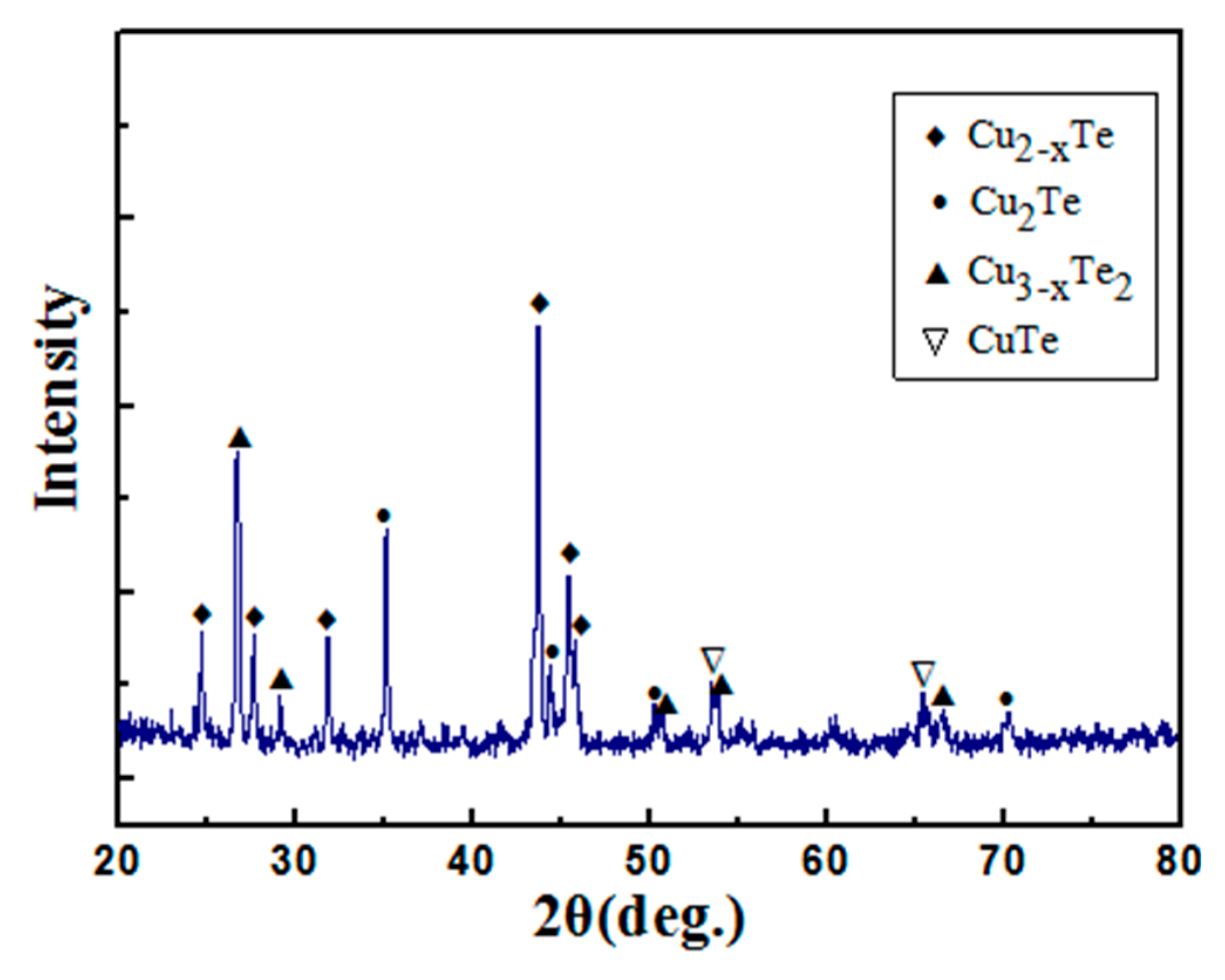
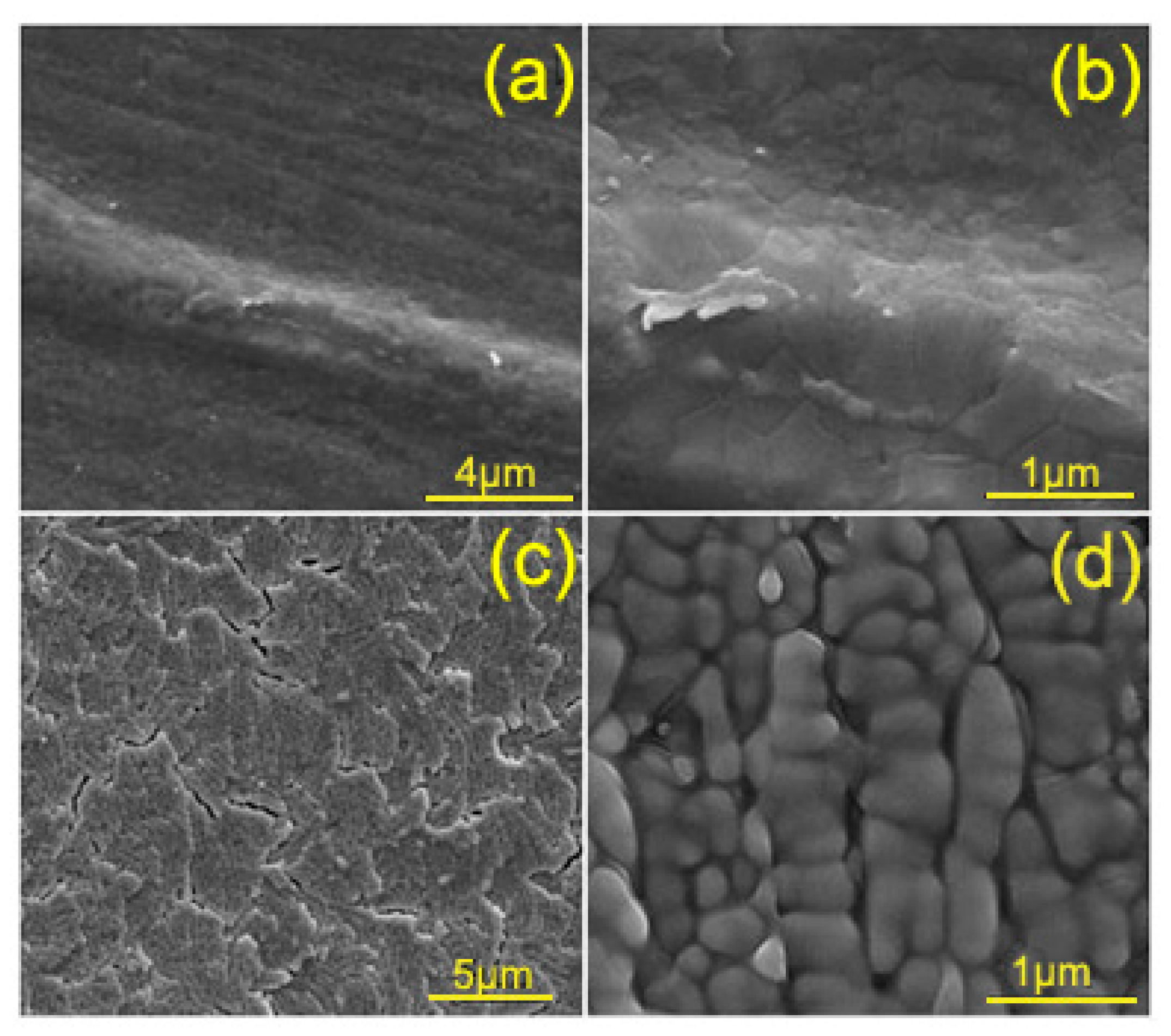
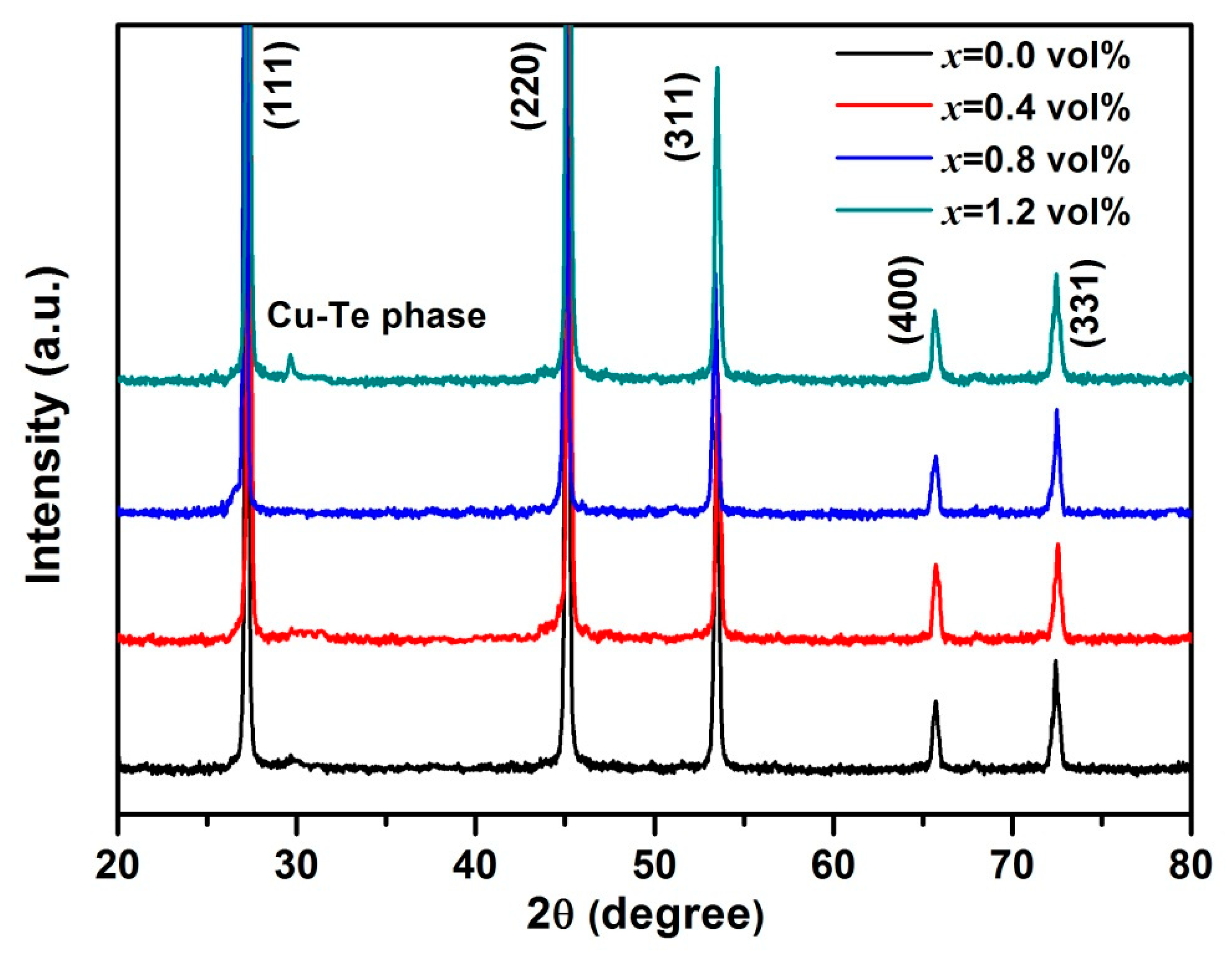


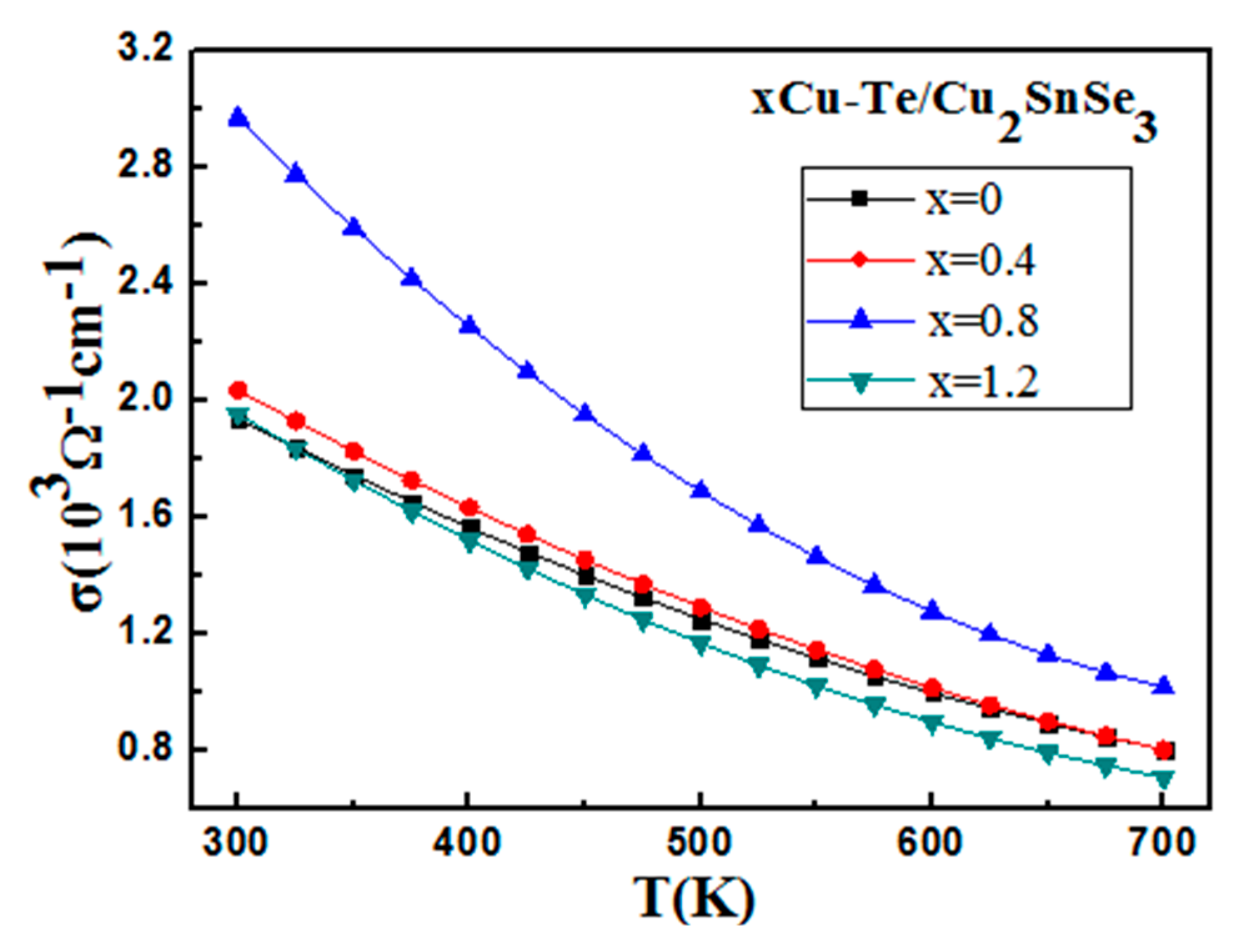
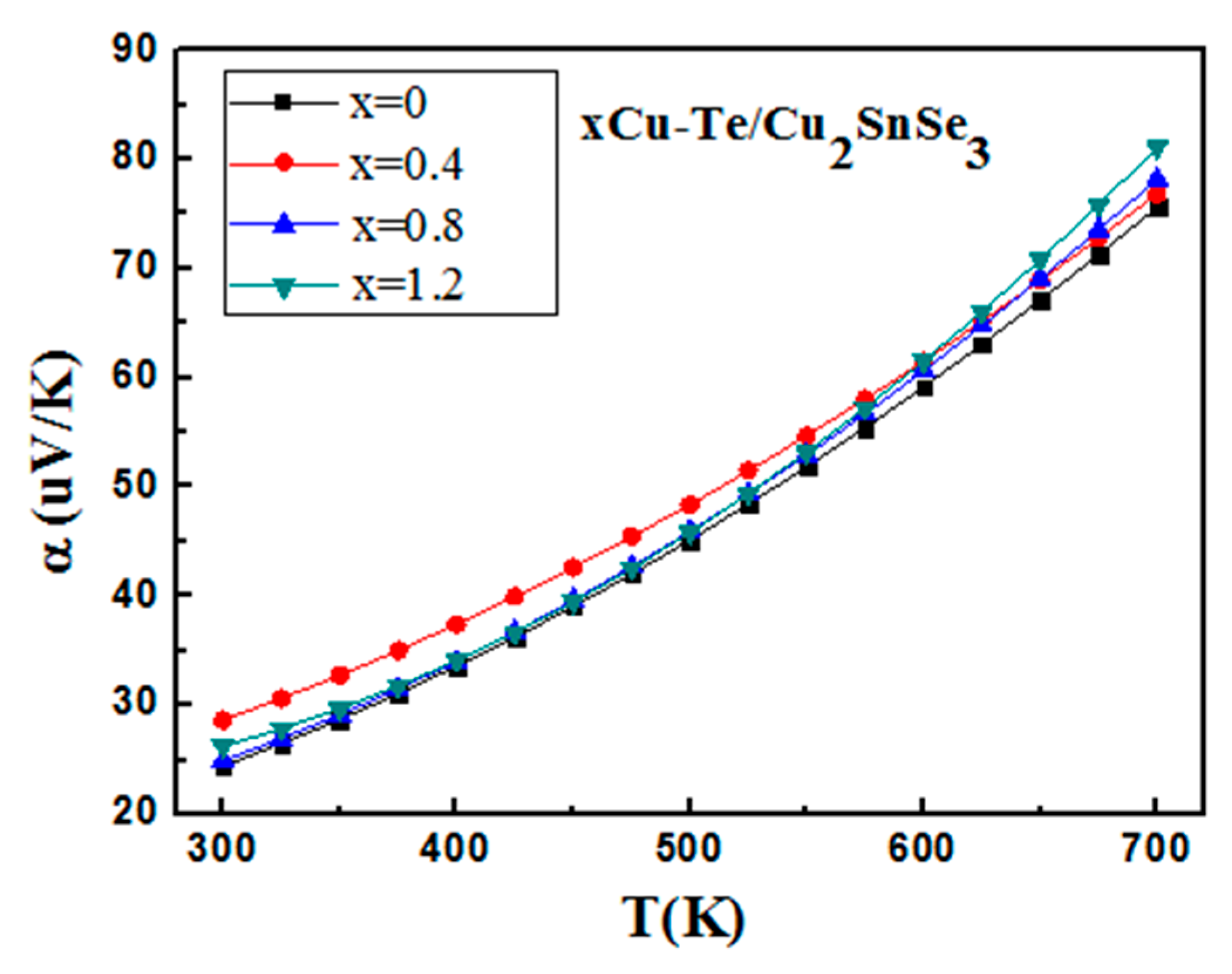
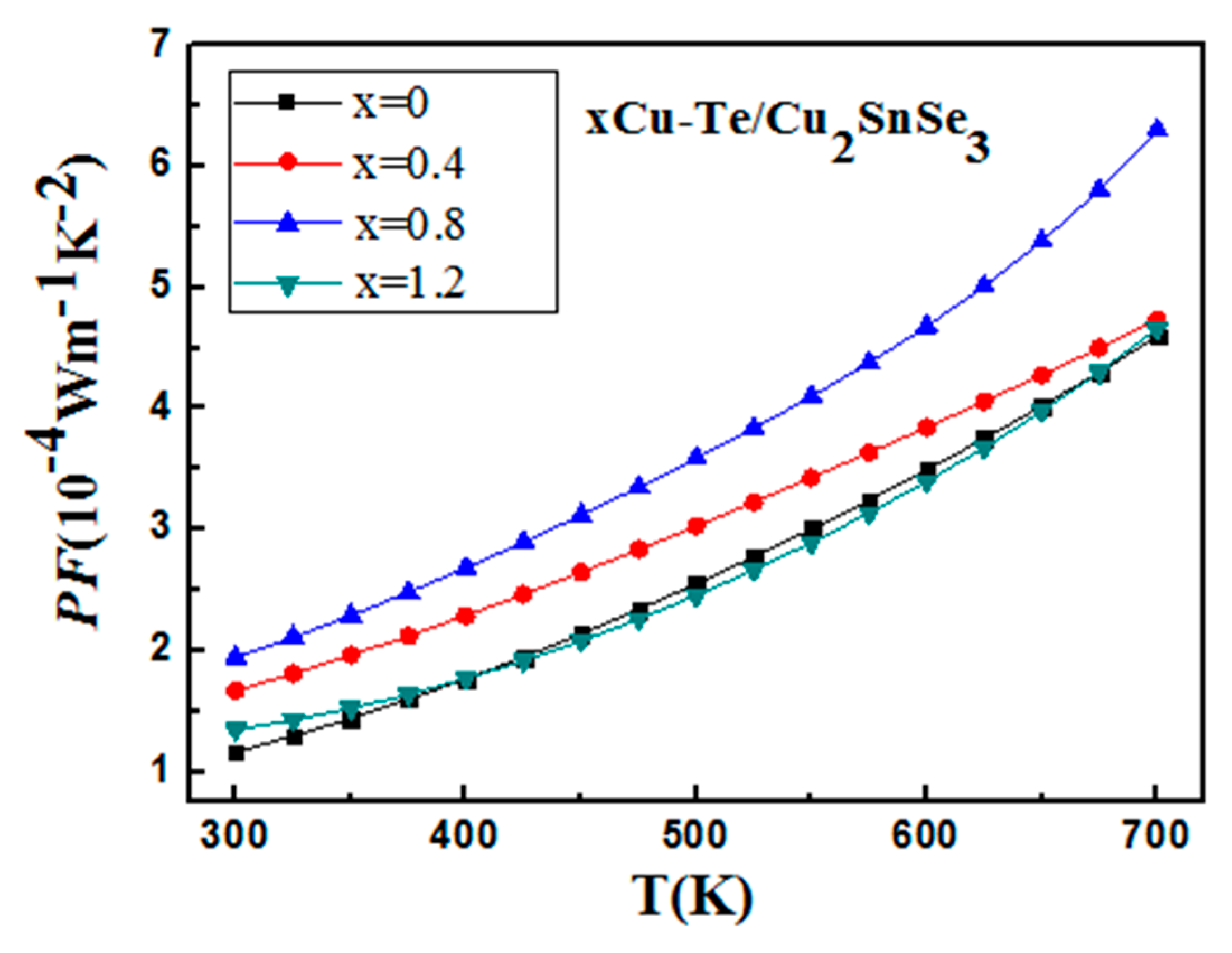


| x | Hall Coefficient RH (10−3 cm3/C) | Carrier Concentration n (cm−3) | Carrier Mobility μ (cm2/Vs) | Electrical Conductivity σ (S/cm) | Relative Density |
|---|---|---|---|---|---|
| 0 | 3.368 | 1.866 × 1021 | 7.14 | 1.94 × 103 | 96.2% |
| 0.4 | 3.550 | 1.923 × 1021 | 7.21 | 2.04 × 103 | 95.2% |
| 0.8 | 9.212 | 1.990 × 1021 | 9.63 | 2.97 × 103 | 96.9% |
| 1.2 | 2.257 | 2.291 × 1021 | 6.16 | 1.95 × 103 | 96.3% |
© 2019 by the authors. Licensee MDPI, Basel, Switzerland. This article is an open access article distributed under the terms and conditions of the Creative Commons Attribution (CC BY) license (http://creativecommons.org/licenses/by/4.0/).
Share and Cite
Zhao, D.; Wang, L.; Wu, D.; Bo, L. Thermoelectric Properties of Cu2SnSe3-Based Composites Containing Melt-Spun Cu–Te. Metals 2019, 9, 971. https://doi.org/10.3390/met9090971
Zhao D, Wang L, Wu D, Bo L. Thermoelectric Properties of Cu2SnSe3-Based Composites Containing Melt-Spun Cu–Te. Metals. 2019; 9(9):971. https://doi.org/10.3390/met9090971
Chicago/Turabian StyleZhao, Degang, Lin Wang, Di Wu, and Lin Bo. 2019. "Thermoelectric Properties of Cu2SnSe3-Based Composites Containing Melt-Spun Cu–Te" Metals 9, no. 9: 971. https://doi.org/10.3390/met9090971




